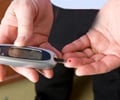If it's not the fatty foods it's the lack of exercise -- or probably both. More and more Arabs living in the wealthy Gulf states are suffering lifestyle diseases, especially obesity and diabetes.
Alarmed governments are now scrambling to counteract the high-calorie fast-food culture that has gripped their desert nations, launching nutritional awareness programmes, encouraging children to plays sports and setting up health check-up booths in shopping malls.Abdelrazzaq al-Madani, head of Dubai hospital and chairman of the Emirates Diabetes Society, blames rapid economic growth due to windfall oil revenues for the rising obesity levels.
"People have more sedentary jobs now" compared to a harsher but more active lifestyle in the past, Madani told AFP.
Tied with that is a boom in restaurants offering foods from around the world, and high-calorie fast food, Madani said.
Adolescents as young as 15 and 16 are developing diabetes, he said, adding that there has been a surge in obesity among younger children and especially teenagers.
Official figures published this week said that 70 percent of adults and 12 percent of children in the UAE are overweight, while a fifth of the overweight children are at risk of developing obesity.
Advertisement
"It is a killer disease. Eighty percent of patients with diabetes die of heart attacks, while heart attacks are one of the major killers in the United Arab Emirates -- maybe the second killer after road traffic accidents."
Advertisement
"I believe that if we did the same study today, we would find even higher numbers than in the previous study," Madani said. Official data say the UAE figure is expected to reach 28 percent in 2025.
The UAE health ministry said this month that a third of patients in the country's hospitals have diabetes, and that treatment of the disease costs the state some 735 million dirhams (200 million dollars) annually.
Other Gulf states are faring little better in their fight against the disease, with diabetes levels in Qatar at 15 percent, Bahrain at 14.3 percent and Oman at 13 percent, doctors across the region told AFP
Mariam al-Ali, a pediatrician at Hamad hospital in Qatar, said that in 2007 they discovered that 35 percent of children under 14 in the emirate were diabetic, compared to only seven percent 10 years earlier.
In Bahrain, health ministry official Mariam al-Jalahema said that a study conducted in 2006 on a sample of 1,769 people showed that 16.8 percent of women and 11.7 percent of men had diabetes.
While there are no accurate numbers available for Saudi Arabia, the kingdom's official SPA news agency reported this month that 25 percent of the oil-rich kingdom's over-30 population is diabetic.
The head of the diabetes awareness programme in Kuwait, Ahmad al-Shatti, told AFP meanwhile that one in every four Kuwaitis has diabetes.
The scary statistics have led the UAE health ministry to launch a nationwide campaign to raise awareness about the health risks tied to obesity and diabetes.
In one such drive, the ministry has joined forces with the United Nation's Children's Fund (UNICEF) to fight obesity among children.
The project includes programmes to educate mothers on healthy nutrition for their children and, in collaboration with the education ministry, encouraging school pupils to engage in sports and follow a healthy diet.
A number of schools in Abdu Dhabi, the UAE's capital, have organised running races to promote the idea of a healthier lifestyle, while one school canteen reportedly stopped selling junk food.
Other Gulf states have launched similar awareness campaigns, which include check-up booths in malls as well as TV programmes and educational seminars that discuss the problem.
Also raising alarm in the Gulf, meanwhile, is a condition known as "diabetic foot" which leads to dozens of foot amputations each year.
The condition, which results in lack of feeling in the foot due to damaged nerve endings and inadequate blood flow, is a direct result of diabetes.
Wounds and ulcers that are left untreated could lead to infection in the foot and amputation if the infection further deteriorates.
Abdulaziz al-Gannass, a foot and ankle surgeon in Riyadh, told AFP in March that some 90 people had a foot amputated each month in the Saudi capital alone.
Gannass said that people as young as 30 now come in for diabetes-linked foot amputations, and that he was "shocked to see them in the emergency room".
Physiotherapist Amal al-Shamlan, head of the rehabilitation section at Al-Wasl hospital in Dubai, said the Emirates Physiotherapy Society held a week-long campaign in March with the motto "foot first" after learning that 49 foot amputations were carried out in the UAE last year.
Source-AFP
LIN














